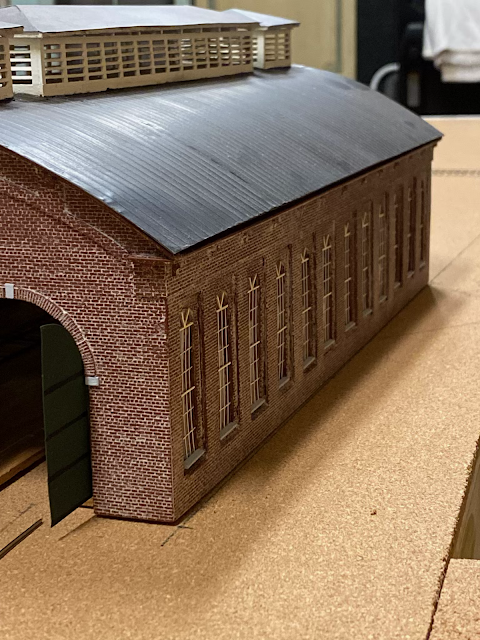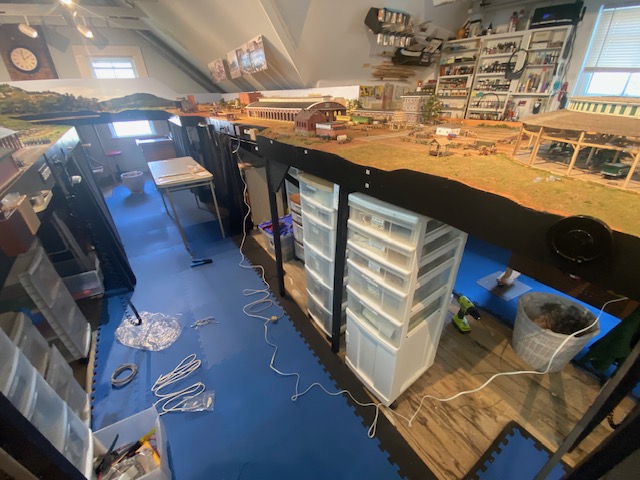An HO scale model of the rail line between Chattanooga TN. and Atlanta GA.
Tuesday, December 17, 2024
NICK KANE"S SACRAMENTO VALLEY RR, Part 1
Wednesday, December 11, 2024
PROTOTYPE LINESIDE DETAILING
Ideating new possible topics for our virtual meets, I was paging through one of my period RR books and noticed photo content that reminded me of my layout. Then looking about on my layout I thought lineside details may be a good topic. So, during one of our virtual meets awhile back I did a clinic on just that. Here are a few photos that reflect what the real rail lines and centers may have had along the rails. OR, what someone might see that could be considered as such. One fascinating aspect is that these could have been as tall as eight rails high given the need.
Here is the classic snake or worm fence.
Here is one, nearly completed, of my snake fences. Thanks to Starbucks, I collected a small handful. I split em and configured the rails into HO scale versions.The modeled version.
Sunday, July 14, 2024
ATLANTA YARD EXPANSION
My initial design had the Atlanta trackwork mostly focused on the north end and along the aisle. Below is a general view. Backdrops are panels done by Brian Kammerer. The track that traversed the left side of the Car Shed was initially designed as a continuous running for open house visitors. Eventually I removed the bridge to expand the aisle behind Chattanooga beyond the roundhouse.
However, the last panel was pulled in a recent operating session for ease of access. One operator, Andy Estep, suggested connecting that continuous run track as a run around for a loco coming onto that run-around track. Hence, the idea was born! Above, the track to far right was the continuous run connection. I laid a switch on existing track to begin planning the new run-around.
Wednesday, May 29, 2024
Lessons Applied from May Ops
During the May ops, operators were forthcoming with two excellent suggestions. One was to add two throttle fascia panels to conduct their operating. One was added to Tunnel Hill. This allowed for ease of access as it can be a tight area for 2-3 crews. The other was in Atlanta. This one will provide access to running into and out from the roundhouse.
The craziness to install Atlanta...
Laying new cable...
But AFTER a whole lotta stuff needed to be moved...May Operating Session
Our latest and perhaps one of our most enjoyable train runnin sessions.
Left to right, Andy, Heath, DC, Ted, Rob and Jim. Unfortunately Corey had to leave early.
When planning these sessions, there are always one or two operators that may need to cancel last minute. I lost my mind as I had spent more than a week working out the schedules for two member crews. Another lesson learned... KEEP MY COOL! It worked out great. There were four trains and two had solo operators. This helped me realize that one person can do all the jobs. Now I just need to make a few adjustments to minimize all the paraphernalia an operator needs to carry. Easy!This view shows the new ops elements I incorporated into different train orders. The car with derrick is the wreck train with two attached cars. These were mentioned in a couple of writings by trainmen who rode the W&A at the time and other lines such as the VA Central, East TN & GA and GA RR.
Bottom left is a telegraph car. This would take new poles and insulators to set along the line or to replace those needed.
The keg is one of whiskey which seemed appropriate to "support" the troops. Next is a grease bucket, the idea coming from Wilber Kurtz notes that one engineer was asked to meet another train to hand of a bucket of grease.
Last are pole cars. Lever cars were had not arrived on the W&A in 1863. However, these pole cars were on occasion transported to an area where workers would need to travel down a line to either inspect of conduct minor repairs.
During this session, each of these were added to a crew's train orders. The feedback was ecstatic as it provided a hands-on experience for the operators.
Sunday, March 3, 2024
Harp Stand Build
Harp stands were the way for switching track mid 1800's. These of course were known as stub switches, the most common turnout configuration until point switches were created.
I had installed a 3 way switch about 10 months ago. My initial throw mechanism was an Arduino. Unfortunately, although it worked, knowing how to program it was WAY outside my wheelhouse!Necessity is the mother of invention, as the saying goes. And I had more than necessity; I had HIGH need. This is a key area for my operating plans. I decided to use or build my own harp stand. First choice was the PCS hand throw. Al Mueller built one to operate. Unfortunately this stand is good for only a 2 way. I'd need to convert my rail from code 83 to 55 to make that a possibility. That was out of the equation as I had close to 200' of track. Build the harp was the most obvious possibility.
Using the PCS stand as the idea, I did a crude drawing, guessing the size needed. I went with about O scale to give it the length to reach across three rails.
Fabrication of the throw bar positioning cap was a critical build. Overall, my build came with a lot of luck as I measured only the distance the headblock would need to travel to ensure the fly rails reached the outer stock rails.
Initially I used a tri-corner file to start the cut for each of the three slots to hold the throw bar position.
Fabricating the legs and frame required 2 sizes of KLM angle brass stock. Angle was chosen for greater stability. The way to bend the angle is to make a notch which reduces an awkward bend and a cleaner angle in the leg.
Monday, January 29, 2024
OP Session January 28, 2024
Another fun ride on the W&A, north branch! Operators included members from our ACW RRs group, Corey, Bill and DC, https://groups.io/g/CivilWarRailRoads. Another person, Glyn is a fellow board member in our NMRA Division, and Ed who is a member from our local model RR club, Garden State Central http://www.gardenstatecentral.com/
I had three train schedules prepared. However, a couple of folks couldn't make it last minute And, I didnt even think about removing the one train. This, however, made for an interesting movement for the crew that encountered this train as it blocked their route.
One of the compelling aspects of modeling this era is the consistent randomness of situations which were very prototypical then given the demands for both civilian and military needs and requirements.
Below, Bill is Yardmaster in Chattanooga while Ed and Glynn are preparing to depart for points south.
Glynn and Ed taking out the Catoosa for its first run of the day, also a mixed freight with a few passenger stops scheduled along the way.




































